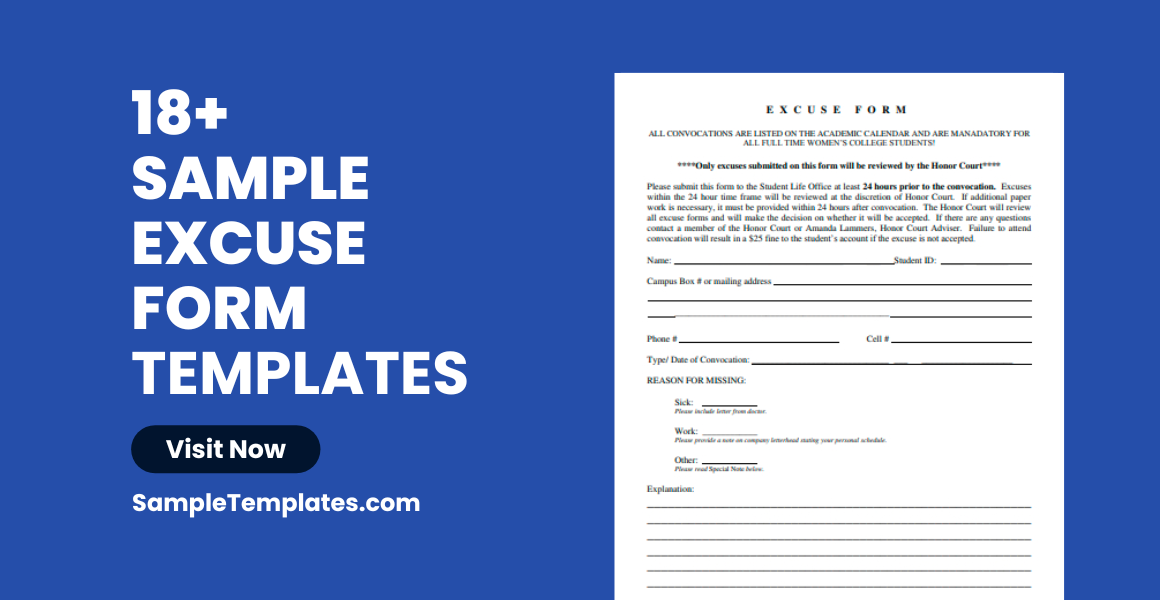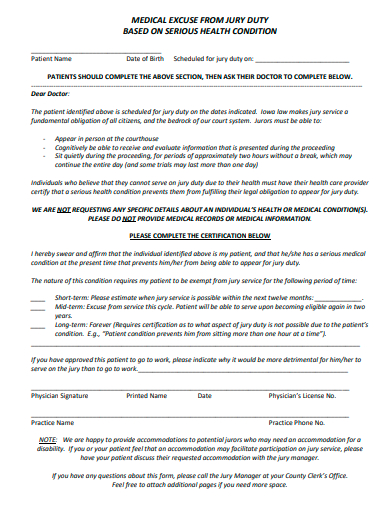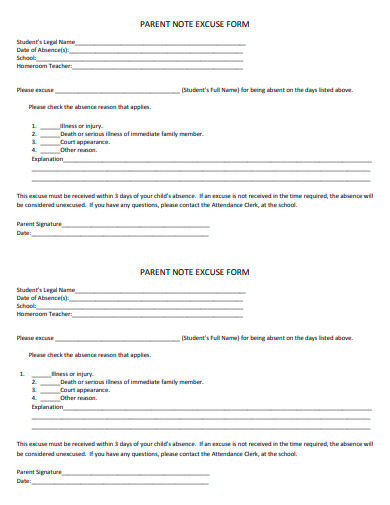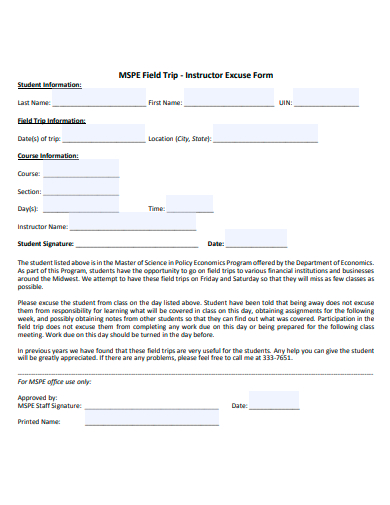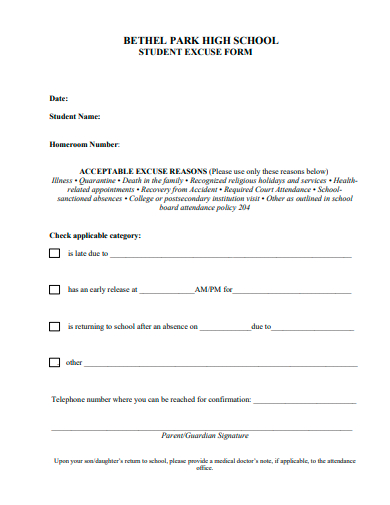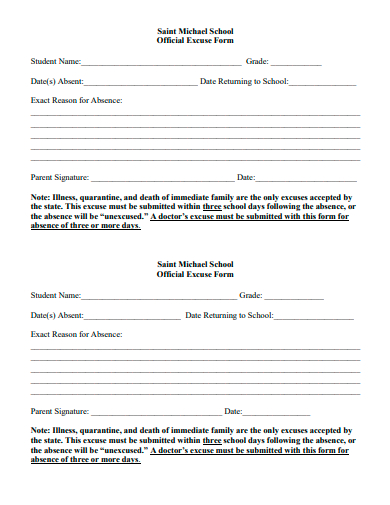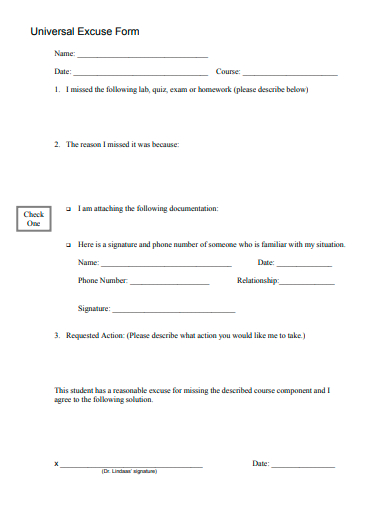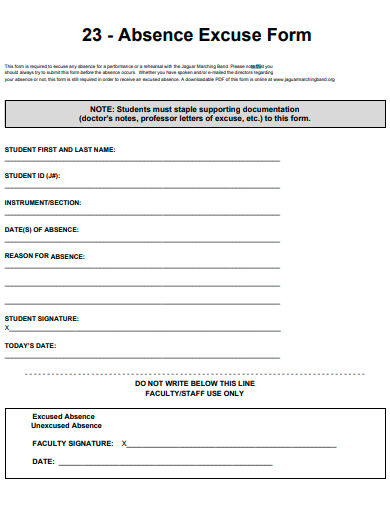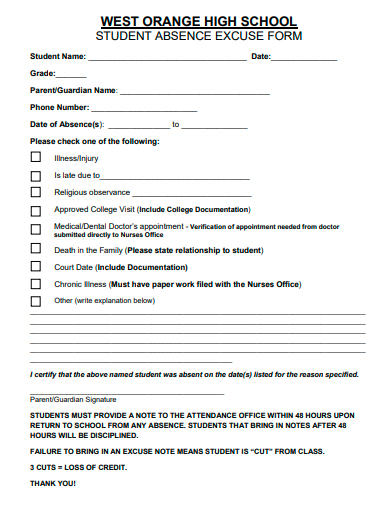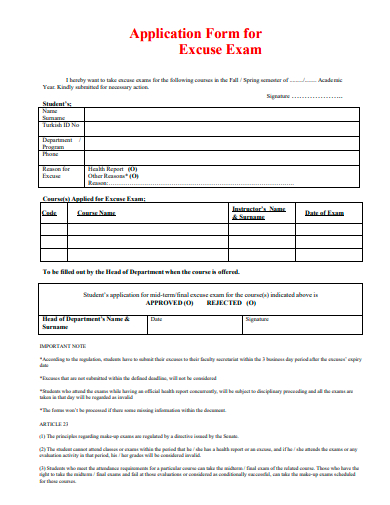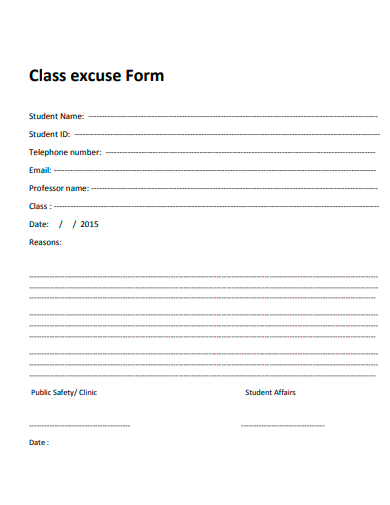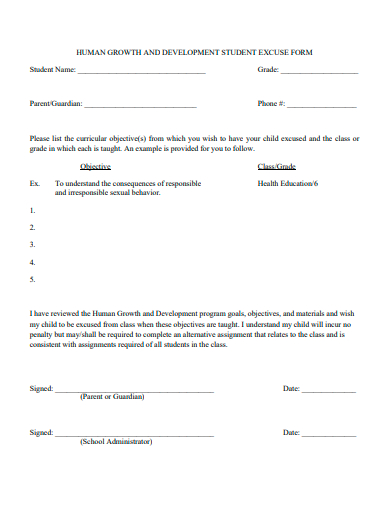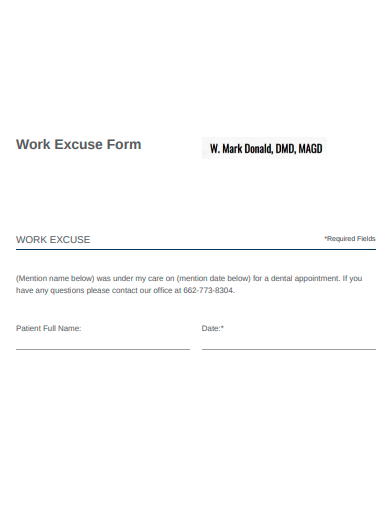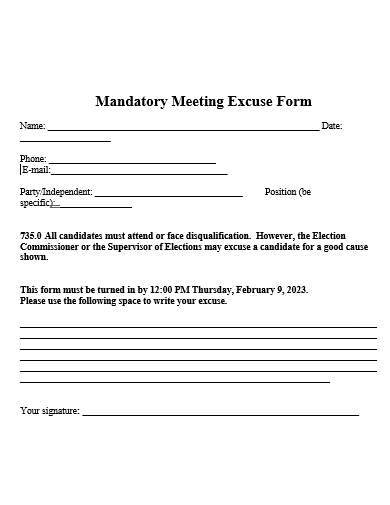In structured environments like workplaces or educational institutions, the ‘Excuse Form’ serves as a bridge of communication. It’s not merely about seeking leave; it’s about conveying legitimate reasons and maintaining transparency. Whether you’re grappling with unforeseen emergencies or planned absences, a well-structured Excuse Sample Form ensures that all parties stay informed. Join us as we delve into the nuances, design, and best practices for crafting an effective and comprehensive Excuse Form.
18+ Excuse Form Samples
1. Sample School Absence Excuse Form Template
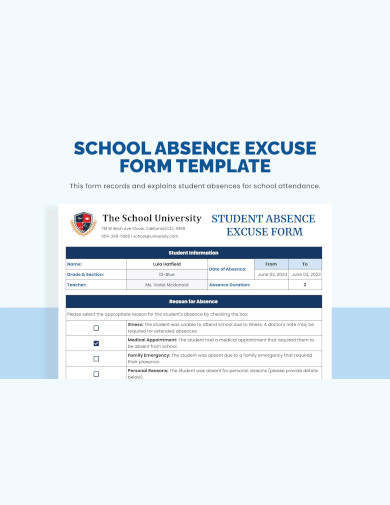
2. Sample Medical Excuse Form Template
3. Sample Parent Note Excuse Form Template
4. Sample Excuse Request Form Template
5. Sample Instructor Excuse Form Template
6. Sample Student Excuse Form Template
What is an Excuse Form?
An excuse form is a formal document that an individual submits to a governing body, like a school or an employer, to provide a reason for their absence or any deviation from the norm. It serves as tangible evidence, ensuring both parties are on the same page. You can also see more templates like Doctor Excuse Samples.
Understanding Excuse Forms
An excuse form, often associated with academic institutions or workplaces, is a design document that provides evidence or reasons for one’s absence or inability to fulfill a specific duty or requirement. Whether it’s due to sickness, a family emergency, or another valid reason, excuse forms serve as a bridge of communication between the individual and the institution or employer.
Purpose and Importance of Excuse Forms
At their core, excuse forms serve as a bridge between an individual and an institution, be it a school, workplace, or any other entity. They offer:
- Documentation: Providing a written record of why an individual couldn’t adhere to a set sample schedule or norm.
- Accountability: Ensuring that there’s clarity and accountability for absences or deviations.
- Structured Communication: A formalized way to convey reasons for absences, ensuring consistent communication.
Types of Excuse Forms
Depending on the scenario, there are different types of excuse forms:
- Medical Excuse Form: Often provided by a healthcare professional, it verifies that an individual was ill or had a medical appointment.
- Bereavement Excuse Form: Used when there’s a death in the family or a related sample event.
- Jury Duty Excuse Form: Verifies an individual’s participation in the civic duty of jury service.
- Educational Trip or Event: When students participate in educational activities outside their regular school.
Components of a Standard Excuse Form
While formats may vary, a typical excuse form often contains:
- Name of the Individual: The person requesting the excuse.
- Date(s) of Absence: Specific day or range of days.
- Reason for Absence: Whether it’s illness, an event, or another reason.
- Verification: This could be a doctor’s note, a death sample certificate, or any other verifying document.
- Signature: From the individual or the verifying authority.
The Process: Submitting an Excuse Form
The submission process often follows these steps:
- Filling the Form: The individual fills out the relevant details.
- Attaching Verification: If required, attach supporting documents.
- Submission: Handing over or emailing the form to the relevant authority or department.
- Approval or Denial: The institution or employer may accept the excuse, ask for further information, or deny it.
Legal and Ethical Implications
Using an excuse form is not just a matter of routine; it has legal and ethical implications:
- Truthfulness: Submitting false information can lead to penalties or disciplinary actions.
- Confidentiality: Especially with medical forms, there’s an expectation of privacy and discretion.
- Consistency in Application: Institutions and employers need to ensure they handle all excuse forms consistently to avoid biases or favoritism.
Transitioning to Digital: The Modern Excuse Form
As with many traditional processes, the excuse form is evolving in the digital age:
- Digital Platforms: Schools and businesses are adopting online portals where forms can be filled and submitted electronically.
- Instant Notifications: Automated notifications can alert both the individual and the authority instantly upon form submission or status change.
- Data Management: Digital forms make storage, retrieval, and data analysis more streamlined and efficient.
Information Required on Excuse Forms
Excuse forms are designed to provide a clear and organized record of the reason(s) for an individual’s absence or deviation from a specific obligation. The exact details required can vary based on the institution or organization’s requirements, but generally, the following components are commonly found on most excuse forms:
1. Personal Identification
- Full Name: The complete name of the individual submitting the excuse.
- ID or Registration Number: Often used in schools or workplaces to quickly identify and link the individual to their records.
- Class/Grade/Department: Relevant especially in educational or corporate settings to specify where the individual belongs.
- Date of Birth: Sometimes used, especially if the ID number isn’t provided, to further identify the individual.
2. Details of the Absence
- Date(s) of Absence: Specific day or range of days when the individual was absent or expects to be absent.
- Time of Absence: If applicable, specifying the duration of the absence, especially useful in workplaces for partial-day absences.
3. Reason for Absence
- Nature of Excuse: General categories like medical, bereavement, jury duty, personal, etc.
- Detailed Explanation: A brief description providing context. For instance, under ‘medical’, one might specify ‘flu’ or ‘dental surgery’.
4. Verification Details (if required)
- Document Attachment: Some excuse forms might have an option or requirement to attach corroborating documents, such as a doctor’s note, death certificate, or jury summons.
- Name & Contact of Verifying Authority: For instance, if the absence is due to a medical reason, the name and contact information of the doctor or clinic might be required.
5. Declaration and Confirmation
- Statement of Truthfulness: A declaration where the individual confirms that the information provided is accurate and truthful.
- Signature: The individual’s signature (or guardian’s, in the case of minors) to authenticate the information.
- Date of Submission: The day the form is being filled out and submitted.
6. Administrative Use (Optional)
- Received By: The name of the person receiving the form, especially if it’s submitted physically.
- Date of Receipt: The day the form was received by the institution or organization.
- Approval Status: A space where administrators can indicate whether the excuse was accepted, pending further information, or denied.
- Comments/Notes: Any additional information or decisions by the reviewing authority.
7. Sample Official Excuse Form Template
8. Sample Universal Excuse Form Template
9. Sample Planned Absence Excuse Form Template
10. Sample Absence Excuse Form Template
11. Sample Student Absence Excuse Form Template
12. Basic Excuse Form Template
13. Sample Rehearsal Excuse Form Template
14. Sample Excuse Exam Application Form Template
15. Sample Class Excuse Form Template
16. Sample Daycare Excuse Form Template
17. Sample Development Student Excuse Form Template
18. Sample Work Excuse Form Template
19. Sample Mandatory Meeting Excuse Form Template
How do you Create a Excuse Form?
Crafting an excuse form is essential for institutions or organizations that require documented reasons for absences or tardiness. Whether it’s for schools, workplaces, or other formal settings, an excuse form acts as an official record of an individual’s reason for not fulfilling a commitment. You can also see more templates like Registration Forms. Here’s a straightforward guide to help you design one:
Step 1: Define the Purpose and Parameters
Before you start with the design, understand why you need the excuse form. Is it to record student absences in a school? To document employee leave reasons? Knowing the purpose will guide your content. Also, determine the parameters. For example, if the form is for school, you may only accept certain excuses like illness or family emergencies as valid.
Step 2: Choose a Format
Decide whether your form will be digital (like a PDF form) or printed. Both have their pros and cons. Digital forms are easy to distribute and store, while printed forms can be more accessible in places with limited tech. Tools like Microsoft Word, Google Forms, or specialized software like Adobe Acrobat can help in creating both types.
Step 3: Design the Layout
Start with a clear heading, such as “Excuse Form.” Below the heading, have spaces for basic details:
- Full Name
- Date
- Class/Department (if applicable)
- Date of Absence/Tardiness
- Reason for Absence/Tardiness (You can provide options like ‘Illness’, ‘Family Emergency’, ‘Doctor’s Appointment’ to choose from)
Make sure the design is clean, ensuring that each section is clearly separated. If using a digital format, make sure the form fields are easily clickable and fillable.
Step 4: Incorporate a Verification Section
For added authenticity, include a section where a verifying authority can sign or stamp. This could be a doctor, school nurse, or supervisor. This section should include:
- Verifier’s Name
- Verifier’s Contact Information
- Date of Verification
- Signature/Stamp space
This verification assures the form’s validity and confirms that the excuse isn’t fabricated.
Step 5: Add a Declaration and Submission Instructions
At the bottom of the form, include a declaration where the person filling the form attests that the information provided is true. This could read something like, “I affirm that the details mentioned above are accurate to the best of my knowledge.” Below this, provide a space for the individual’s signature and the date of signing.
In Conclusion, Excuse forms are while simple at first glance, play a crucial role in maintaining structure, transparency, and accountability in various settings. As with all such tools, it’s essential for individuals and institutions to use them responsibly and ethically. With the digital age upon us, the nature and format of excuse forms might evolve, but their core purpose will remain unchanged: to document and communicate valid reasons for deviations from the norm. You can also see more templates in SampleTemplates.com site!
Related Posts
Parent Consent Form Samples & Templates
Sample Release of Liability Forms
Sample Training Feedback Forms
Sample Sworn Affidavit Forms
Agreement Form Samples & Templates
Vehicle Inspection Forms Samples & Templates
Sample Employee Advance Forms
Sample Child Travel Consent Forms
Sample Testimonial Request Forms
Sample Employee Details Forms
Sample Divorce Forms
Sample Attestation Forms
Employee Performance Appraisal Form Templates
FREE 9+ Sample Presentation Evaluation Forms in MS Word
FREE 10+ School Admission Form Samples & Templates in MS Word | PDF
